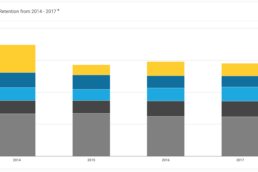You have seen the lifts that other nonprofits are getting from A/B testing, and now you are ready to do it yourself. But you might not be sure exactly where or how to start. So in this A/B testing guide for nonprofits, you will find some tips to begin optimizing your online fundraising so you can realize greater impact.
Knowing What to Test
Ask yourself the question, “Where can I get the most return for my effort?” Because you have limited time and resources, spending time on things that will produce the most return is critical. Nothing says return like increased donations, so we suggest you start at the bottom of the donor funnel, the donation page. If you can improve that page, you are going to get more income.
Here is how you start:
1. Identify your conversion goal.
You need to have a target so that you know what success means. If not, you won’t be able to design an effective test to achieve it. Start by knowing where you stand today. Determine your donation form conversion rate (number of visits to the page divided by the number of donations given). The benchmark nonprofit donation conversion rate is 4.29%.
The benchmark nonprofit donation conversion rate is 4.29%.
2. Make sure you can measure your conversion goal.
If you can’t track it, you can’t optimize it. This is where Google Analytics comes in. Set up a conversion goal so you can track the goal. Better yet, enable e-commerce tracking in Google Analytics so you know the value of each visit. If you are using a third-party donation form that sends donors off your site to a secure landing page, make sure you know the number of people that your site sends to that page (use the number of visits to the page before the donation form, then multiply that by the exit rate percentage). Then you can see the number of gifts you get during the same time period so you can figure your conversion rate.
3. Craft your testing hypothesis.
Try to be as specific as possible. A well-developed hypothesis will enable you to extract the maximum amount of learnings from the test. Here’s an example of a good hypothesis: “Removing friction from the giving process by eliminating gift designations will increase the conversion rate.” Make sure you write it down so you have something to go back and reference when the test is complete.
4. Calculate your estimated sample size.
This will help you get a sense for how long your test needs to run. You can use Optimizely’s Sample Size Estimator tool. You will need to know your estimated conversion rate, and you can use your current benchmark (step number 2) or the nonprofit benchmark rate of 4.29%.
5. Design your treatment.
Now that all of the planning work is done, you are ready to create a variation of your page. Your existing page will become the “Control,” and the variation will become the “Treatment.” For your first experiment, we would recommend more of a “radical redesign” to maximize your potential lift. Here is more about radical redesigns.
6. Set up your experiment.
In order to run your experiment, you need to split your traffic. There are a number of tools that will allow you to do this. The ones that we like to use are Visual Website Optimizer (VWO) and Optimizely. You can use Google Analytics as well, but we have found it is hard to set up for most organizations and you have less control over the amount of traffic that gets sent to the pages. You can find a step-by-step guide to using Google Analytics to run an A/B split test here.
7. Validate results and document learnings.
Once you start getting results in, you can use NextAfter’s online test validator to determine if you have a valid test result. If not, you can let the test continue to run or stop it and create a new treatment.
You also want to make sure that you document your learnings so that you can go back to them months later and refresh your memory on why you did what you did. We use WinstonKnows.com for this purpose, I highly recommend it.
For some ideas on specific tests to run on your donation page, check out another resource from NextAfter “How can I improve my donation page?”
To get sent new blogs via email, sign up here:
Related Posts
August 13, 2016
Nonprofits Leaving Billions on the Table Due to Fundraising Failures
Looking at the data after giving online…



